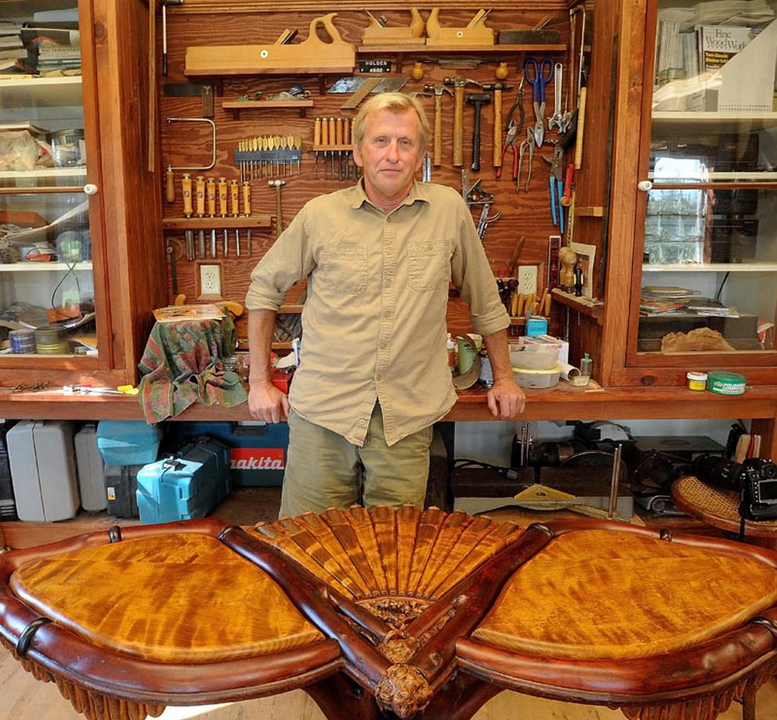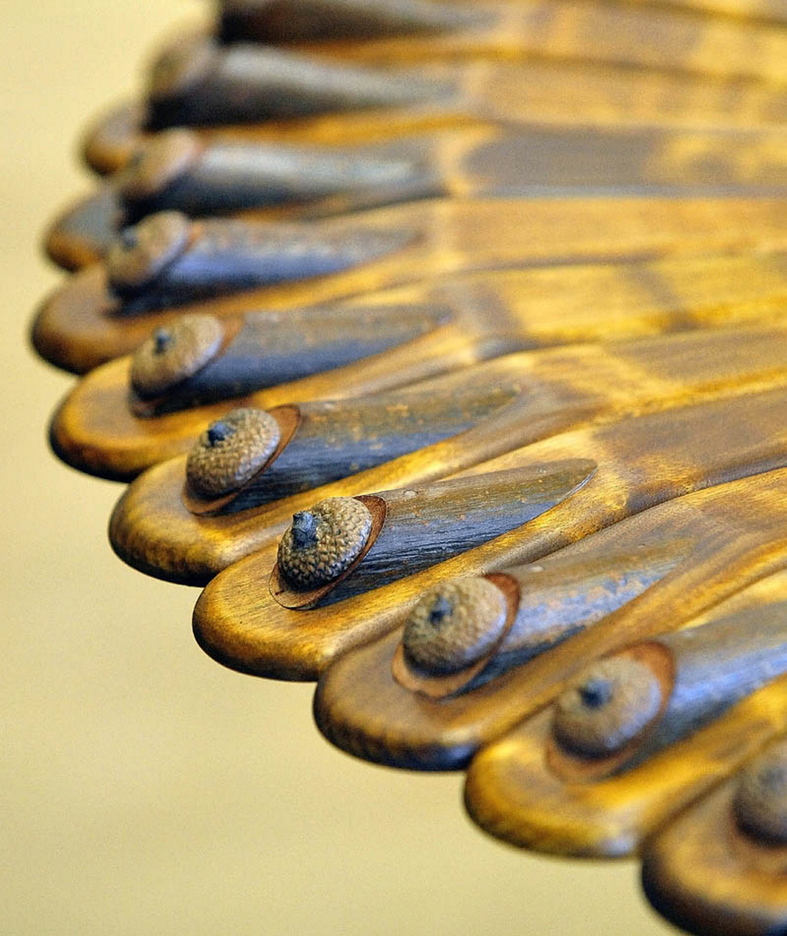NORRIDGEWOCK — Antique stores and daily walks are the inspiration for rustic furniture maker Randy Holden, who crafts six to seven unique pieces at his studio each year.
Holden, 57, is one of just a few people in the country who make a living creating high-end furniture that incorporates raw materials such as roots and deer antlers and is inspired by nature.
“He’s brilliant. Probably in every state there’s a number of people who do it, and probably in the Adirondacks, where there is more of a tradition there may be more makers, but Randy really is known among people who are interested nationally,” said Peter Korn, executive director of the Center for Furniture Craftsmanship in Rockport, an educational center that offers classes for aspiring furniture makers as well as amateurs.
He said that although there are others in Maine who make rustic furniture, Holden has an unrivaled presence nationally.
Inside his Norridgewock studio, Elegantly Twisted Rustic Furniture, located miles down a dusty dirt road, is one of Holden’s most recently completed pieces: “Fallen Angel,” a three-tiered table of yellow pine and cherry that recently won an award for best artist in woodworking at the Jackson Hole Fall Arts Festival, an annual 11-day cultural celebration that features art, music and culinary events and attracts thousands to Jackson Hole, Wyo.
The winning table incorporates the root system of a tree that Holden found near a reservoir in Skowhegan, moose antlers and deer antlers, and is an example of rustic – a style of furniture that rose to popularity in the late 1800s and traditionally uses raw parts of trees such as bark, branches, twigs and burls.
Today it remains a popular fixture of vacation homes and lakeside resorts.
“I think the enduring appeal is this idea of the connection to the land, living off the land and being independent. Over time I think it’s become associated with the idea of spiritual restoration, rest, relaxation and re-establishing that connection with nature,” said Laura Rice, chief curator for the Adirondack Museum in Blue Mountain Lake, N.Y. The museum, in the Adirondack mountains, focuses on the history of the area and the relationship of people with the wilderness.
The Adirondacks are known for popularizing rustic furniture, although the style is not necessarily unique to upstate New York or even the United States, said Rice, who said it is something that is found across time in places that have mountains, woods and water. Rustic is defined by its inspiration in natural settings and incorporation of materials that reflect the environment, and it is rare for imported wood to be used, she said.
In the United States, rustic furniture rose to popularity in the 1870s, when some of the first camps started to appear in the Adirondacks and wealthy people began buying property for second homes, said Rice. The landscape became an important and defining feature of the country as more people migrated away from the major cities on the East Coast.
“People were looking for a place to escape to, to let their fantasies come to life – not just in their natural surroundings but in furniture and architecture as well,” said Rice.
Holden, a graduate of Skowhegan Area High School, worked as a carpenter making cabinets and doing woodworking in homes before he started making rustic furniture full time in 1994. He first became interested in the idea while traveling in California, where he became fascinated with giant redwood trees and started collecting driftwood, he said.
“That was the first time I ever thought to myself I could make a table. I could have a piece of furniture,” said Holden.
Years later he was on a bicycling trip with his wife, Linda, in Tasmania, where he saw a handmade chair that brought the idea back.
There are three pieces of furniture in Holden’s studio, including the “Fallen Angel” piece, which he estimates will sell for about $20,000. It took him three months to build, starting from the time he extracted a series of roots that form the base of the table.
Most of his sales are to people looking to furnish second homes, many in the Adirondacks or in popular ski resorts towns such as Aspen and Vail in the Rocky Mountains of Colorado. He is also currently working on a commissioned cabinet for a San Diego beach house.
Korn said he admires Holden’s work because he uses ordinary objects in nature to create contrast and visual appeal.
“He does a lot of juxtaposition of elements – bark, natural wood – he gets a lot going in terms of color and texture. I think he plays with those elements really well,” he said.
In “Fallen Angel,” which Holden said reminds him of an angel that has turned evil, he has dyed the roots that form the base black and accented the table with other pieces of yellow pine dyed black. The cherry boards are gently curved like the wings of an angel, and deer and moose antlers adorn the tiers.
Rice said that today the materials used to make rustic furniture depend on where the maker is and what material is available to them, although there are some modern rustic makers who sometimes incorporate more exotic hardwoods or nontraditional materials including copper or other metals into their work.
Holden works from both wood and disassembled antique furniture that he incorporates into new pieces, often for decoration more than function.
Last year he finished building a barn, where he keeps horses, chickens and a collection of wood planks, gnarly sticks and burls, the knots of a tree, most of which he gathers in the late fall when sap has left the trees and they can be cut down without the bark falling off.
“You have to have the woods. If I’m looking for a piece I might collect 100. You have to have that,” said Holden.
He also collects old furniture parts – legs off a table, the round pedestal of another table, drawers from another – and reassembles them, weaving the treasures with deer antlers and other oddities, and often works with no plan of what the piece will end up looking like.
“It kind of takes on a life of its own. There’s only so much you can do with these giant roots. You kind of have to let the wood take off a little bit for you,” said Holden. “It designs itself a little bit as you go.”
Rachel Ohm can be contacted at 612-2368 or at rohm@centralmaine.com
Copy the Story LinkSend questions/comments to the editors.




Success. Please wait for the page to reload. If the page does not reload within 5 seconds, please refresh the page.
Enter your email and password to access comments.
Hi, to comment on stories you must . This profile is in addition to your subscription and website login.
Already have a commenting profile? .
Invalid username/password.
Please check your email to confirm and complete your registration.
Only subscribers are eligible to post comments. Please subscribe or login first for digital access. Here’s why.
Use the form below to reset your password. When you've submitted your account email, we will send an email with a reset code.